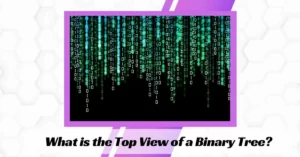Table of Contents
ToggleIntroduction
Top View of Binary Tree Leetcode, A binary tree is a tree data structure where each node has at most two children, referred to as the left child and the right child. In LeetCode, a popular platform for coding challenges, there are many problems related to binary trees, including the Top View of Binary Tree.
The set of nodes are visible when viewing a binary tree from the top is referred to as the top view. In other words, the top view of a binary tree is the set of nodes that are at the highest level of their respective vertical positions.
The concept of the top view of a binary tree is similar to the concept of a skyline in a city. Just as the skyline of a city shows the tallest buildings in each column, the top view of a binary tree shows the nodes at the highest level of each column.
Solving Top View of Binary Tree problems in LeetCode involves traversing the tree in a specific order, recording the nodes at each level of each column, and then returning the nodes at the highest level of each column. This can be done using various traversal techniques such as level order traversal, vertical order traversal, or a combination of both.
The top view of binary tree leetcode problems in LeetCode can be challenging but they are a great way to improve your understanding of binary trees and traversal techniques.
Understanding Binary Trees and Views

The root of the tree is the topmost node, while the leaf nodes are the nodes with no children. Binary trees are commonly used in computer science, especially in algorithms and data structures.
Binary tree views refer to the different perspectives of the tree when viewed from different angles. top view of binary tree leetcode, The most commonly known views of a binary tree are the top view, bottom view, left view, and right view.
The top view of a binary tree refers to the set of nodes visible when the tree is viewed from the top, The bottom view, on the other hand, refers to the set of nodes visible when the tree is examined from the bottom. The left view refers to the set of nodes visible when the tree is viewed from the left, top view of binary tree leetcode, and the right view refers to the set of nodes visible when the tree is viewed from the right.
Binary tree views are important in computer science because they help in visualizing the structure of the tree and understanding the relationships between its nodes. They are also useful in solving problems related to binary trees, such as traversal, pathfinding, and optimization. top view of binary tree leetcode, By understanding binary tree views, developers can write more efficient and optimized algorithms for processing binary trees. Check out:– What is SQL | No 1. Best Information
What is the Top View of a Binary Tree Leetcode?

A binary tree’s top view is the set of nodes visible when the tree is seen from the top. It is the set of nodes that are at the highest level of their respective vertical positions. The top view is similar to the skyline of a city, top view of binary tree leetcode, which shows the tallest buildings in each column.
To visualize the top view of a binary tree, imagine that you are looking down at the tree from above. top view of binary tree leetcode, You can see the nodes that are at the top of each vertical line of the tree. These nodes form the top view of the binary tree.
The top view of a binary tree can be found by traversing the tree in a specific order and recording the nodes at each level of each column. This can be done using various traversal techniques such as level order traversal, vertical order traversal, or a combination of both. top view of binary tree leetcode, The nodes at the highest level of each column are then returned as the top view of the binary tree.
Finding the top view of a binary tree is a useful problem in computer science, and is commonly used in coding challenges on platforms such as LeetCode. By understanding the top view of a binary tree, developers can improve their understanding of binary trees and traversal techniques, top view of binary tree leetcode, and write more efficient algorithms for processing binary trees.
How to approach the Top View of Binary Tree problems in LeetCode?
Approaching the top view of binary tree leetcode problems in LeetCode involves understanding the problem statement, identifying the input and output requirements, and selecting the appropriate data structures and algorithms to solve the problem.
Firstly, the problem statement should be carefully read and understood, and the input and output requirements should be identified. In the case of top view of binary tree leetcode problems, the input is typically a binary tree, and the output is the set of nodes that form the top view of the tree.
Secondly, appropriate data structures and algorithms should be selected to solve the problem. This typically involves using a traversal technique such as level order traversal, vertical order traversal, or a combination of both, top view of binary tree leetcode, to identify the nodes that form the top view of the binary tree. top view of binary tree leetcode, The nodes can be stored in a data structure such as a hash table or a priority queue, to ensure that only the nodes at the top of each column are included in the top view.
Thirdly, the algorithm should be implemented and tested on sample inputs to ensure that it produces the correct output. The algorithm should also be optimized for time and space complexity to ensure that it can handle larger inputs efficiently.
Finally, the solution should be submitted to LeetCode for verification and further testing. top view of binary tree leetcode, If the solution is accepted, it can be further optimized and improved by considering edge cases and refining the algorithm.
Click here to know more about: data science course in delhi
Top View of Binary Tree Algorithm

The top view of a binary tree can be found by traversing the tree in a specific order and recording the nodes at each level of each column. This algorithm can be implemented using a combination of level order traversal and a hash table to store the nodes at each level of each column.
Here are the step-by-step instructions for finding the top view of a binary tree leetcode:
- Initialize a hash table to store the nodes at each level of each column. Initialize a queue for level order traversal of the binary tree.
- Insert the root node of the binary tree into the queue.
- Initialize the horizontal distance of the root node to 0.
- While the queue is not empty, dequeue the next node and its horizontal distance from the queue.
- If the horizontal distance of the node is not already in the hash table, top view of binary tree leetcode, insert the node into the hash table at its horizontal distance.
- If the left child of the node exists, enqueue the left child with a horizontal distance one less than the parent node.
- If the right child of the node exists, enqueue the right child with a horizontal distance one greater than the parent node.
- Repeat steps 4-7 until the queue is empty.
- Iterate through the hash table and return the nodes at the highest level of each column.
- This algorithm is efficient and has a time complexity of O(n), where n is the number of nodes in the binary tree. The space complexity is also O(n), since the hash table and queue both store at most n nodes at any given time.
Coding the Top View of Binary Tree in LeetCode

- To code the top view of a binary tree in LeetCode, you need to first understand the problem statement, requirements, and input-output format.
- Once you have understood the problem, you can proceed to write the code. top view of binary tree leetcode, One approach to implementing the top view of a binary tree algorithm is to use a hash table to store the nodes at each level of each column. The algorithm can then be implemented using a combination of level order traversal and a hash table to store the nodes at each level of each column.
- Here are the steps to code the top view of the binary tree in LeetCode:
- Define a hash table to store the nodes at each level of each column.
- Define a queue to perform level order traversal of the binary tree.
- Enqueue the root node into the queue and set its horizontal distance to 0.
- While the queue is not empty, dequeue the next node and its horizontal distance from the queue.
- If the horizontal distance of the node is not already in the hash table, top view of binary tree leetcode, insert the node into the hash table at its horizontal distance.
- If the left child of the node exists, enqueue the left child with a horizontal distance one less than the parent node.
- If the right child of the node exists, top view of binary tree leetcode, enqueue the right child with a horizontal distance one greater than the parent node.
- Iterate through the hash table and add the nodes at the highest level of each column to the result list.
- Return the result list.
- The code can then be tested on LeetCode to verify its correctness and efficiency.
Sample problems and solutions for the Top View of the Binary Tree in LeetCode
There are several LeetCode problems that involve the top view of a binary tree. Here are two examples along with their solutions:
Problem: ” top view of binary tree leetcode” (LC 199)
Solution: The solution to this problem involves a hash table and a level order traversal of the binary tree. top view of binary tree leetcode, The hash table stores the nodes at each level of each column, and the level order traversal processes each node and its horizontal distance. The nodes at the highest level of each column are then added to the result list.
Problem: “Vertical Order Traversal of a Binary Tree” (LC 314)
Solution: This problem involves printing the binary tree in vertical order, which can be achieved by implementing the top view of a binary tree algorithm. In addition to the hash table and level order traversal, top view of binary tree leetcode, this problem also requires sorting the nodes in the hash table by their horizontal distance and level. top view of binary tree leetcode, The sorted nodes can then be added to the result list in the required order.
These problems are good practices for implementing the top view of a binary tree algorithm in LeetCode. By solving them, you can gain a deeper understanding of the algorithm and how it can be applied in different scenarios.
Also read: data science course pune
Time and Space Complexity analysis of the Top View of Binary Tree in LeetCode
The time and space complexity analysis of the Top View of the Binary Tree algorithm in LeetCode can be broken down as follows:
Time Complexity:
Level order traversal of the binary tree is performed, which takes O(n) time complexity, where n is the number of nodes in the binary tree.
For each node, a lookup operation in the hash table is performed, which takes O(1) time.
Therefore, the overall time complexity of the Top View of the Binary Tree algorithm is O(n).
Space Complexity:
A hash table is used to store the nodes at each level of each column. The maximum size of the hash table can be the number of columns in the binary tree, which can be O(n).
A queue is used to perform level order traversal of the binary tree. top view of binary tree leetcode, The maximum size of the queue can be the maximum number of nodes at any level in the binary tree, which can also be O(n).
Therefore, the overall space complexity of the Top View of the Binary Tree algorithm is O(n).
In terms of time complexity, the top view of binary tree leetcode algorithm is optimal as it performs a single pass of level order traversal over the binary tree. However, in terms of space complexity, the algorithm may not be optimal as it requires storing the nodes at each level of each column in a hash table.
Nonetheless, the space complexity can be considered reasonable given that the maximum size of the hash table and queue is O(n) in the worst case.
Comparison of Top View of Binary Tree Leetcode with other binary tree traversal techniques
Here is a comparison of the Top View of the Binary Tree with other binary tree traversal techniques:
Inorder traversal: Inorder traversal visits the nodes of the binary tree in ascending order of their values. top view of binary tree leetcode, It does not provide any information about the position of the nodes in the tree, so it cannot be used to determine the top view of the binary tree.
Preorder traversal: Preorder traversal visits the root node first, followed by its left and right subtrees. While this traversal provides information about the position of the nodes in the tree, it does not provide any information about the nodes that are visible from the top of the tree.
Postorder traversal: Postorder traversal visits the nodes of the binary tree in a bottom-up fashion. top view of binary tree leetcode, It also does not provide any information about the position of the nodes in the tree, so it cannot be used to determine the top view of the binary tree.
Level order traversal: Level order traversal visits the nodes of the binary tree in level order, starting from the root node. This traversal provides information about the position of the nodes in the tree as well as their level, which can
be used to determine the top view of the binary tree.
Compared to other binary tree traversal techniques, the top view of binary tree leetcode algorithm is specialized to identify the nodes that are visible from the top of the binary tree. While it is not as versatile as other traversal techniques, it provides a unique perspective on the binary tree that can be useful in certain scenarios.
Conclusion
In conclusion, the top view of binary tree leetcode algorithm is an important binary tree traversal technique that allows programmers to identify the nodes that are visible from the top of the binary tree. By leveraging the concept of horizontal distance, the top view of binary tree leetcode algorithm provides a unique perspective on the binary tree that can be used to solve a variety of problems.
In LeetCode, the Top View of the Binary Tree is a popular problem category that tests a programmer’s understanding of the algorithm. Through practice and study of these problems, programmers can develop a deeper understanding of the algorithm and its applications.
As for the future scope of the Top View of Binary Tree in LeetCode, it is likely that more complex problems will be added to the platform that requires the use of this algorithm. Additionally, as LeetCode continues to grow in popularity, it is likely that more programmers will become familiar with the top view of binary tree leetcode algorithm and its applications in the field of computer science.
Overall, the top view of binary tree leetcode is an important algorithm that has practical applications in the field of computer science, and it will continue to be a valuable tool for programmers in the years to come.
Related Blogs:
What is Binary Search Program? Know its Working, Purpose and Advantages
10 Major Difference between BST and Binary Tree
Frequently Asked Questions
What is the Top View of a Binary Tree?
The Top View of a Binary Tree is the set of nodes visible when looking at the tree from the top, i.e., it includes the nodes that lie on the horizontal distance closest to the root node in each level of the binary tree.
How is the Top View of Binary Tree different from other binary tree traversal techniques?
The Top View of Binary Tree algorithm differs from other binary tree traversal techniques such as Inorder, Preorder, and Postorder traversals because it focuses on the horizontal distance of nodes from the root node rather than their relative positions in the binary tree.
What is the time complexity of the Top View of Binary Tree algorithm?
The time complexity of the Top View of Binary Tree algorithm is O(n log n), where n is the number of nodes in the binary tree.
How can the Top View of Binary Tree algorithm be applied in real-world scenarios?
The Top View of Binary Tree algorithm can be used to solve a variety of problems such as finding the shortest path between two nodes in a network, identifying the hierarchy of management in a company, or visualizing the structure of a file system.
What are some common challenges that programmers face when implementing the Top View of Binary Tree algorithm?
Some common challenges that programmers face when implementing the Top View of Binary Tree algorithm include understanding the concept of horizontal distance, handling edge cases such as empty binary trees or nodes with identical horizontal distances, and optimizing the algorithm for efficiency.













